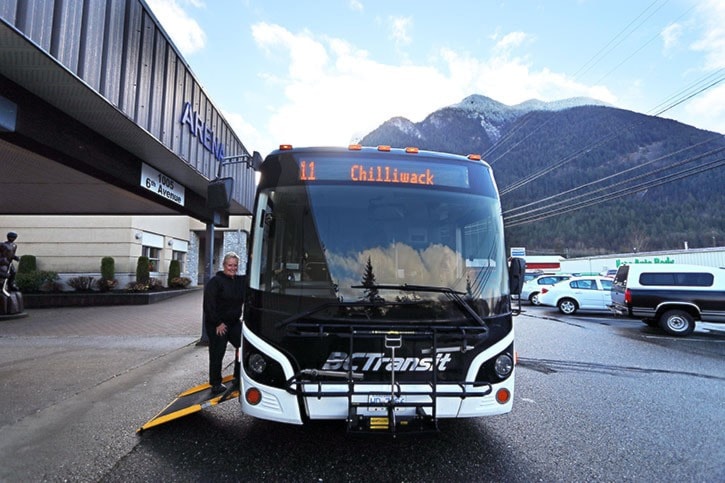“I love it,” said Coun. Heather Stewin after attending the Thursday evening public consultation. “I’m looking forward to it, can’t wait to kick it off in September.”
Three sessions of public consultation in Hope Thursday, Nov. 24 and Friday, Nov. 25 saw residents come out to learn about the proposed bus service between Hope to Agassiz.
Presented by BC Transit’s planner Rebecca Newlove and regional manager Lisa Trotter, they outlined the preliminary plan.
Starting next September, a four-times-daily bus will ply Highway 7 between downtown Hope and Agassiz, a 27-minute ride.
To get to Chilliwack, riders will have to transfer onto another bus in Agassiz. The full journey should take an hour, and the transfer should involve minimal waiting.
At present, the bus schedule is geared towards a commuter’s schedule, with two trips scheduled towards the early morning and late afternoon.
Trotter said the schedules were set based on a feasibility service done in 2012, where public opinion tended towards a commuter service.
Planning the route towards two distinct blocks, rather than evenly scheduling the route through the day, would allow BC Transit to pay a driver for two continuous shifts, and avoids paying the driver in the middle.
All current plans are subject to change depending on the feedback Trotter and Newlove receive.
“Preliminarily, people are really happy to have this service here in Hope,” said Trotter.
Trotter noted that she heard many people want to go to Chilliwack for shopping, medical appointments, or to take the Fraser Valley Express route that connects to Metro Vancouver.
Currently, there is no fare structure yet. Trotter noted that the fares will likely be in a similar range as Agassiz’s and Chilliwack’s bus service, “but we haven’t got that confirmed yet.”
“That’s something that our steering group is working on right now,” said Trotter. “That’s pending an agreement there on the fare structure.”
Bike racks came up as a question posed at the meeting. Newlove explained that the attendee was worried that if they brought their bikes onto the Hope to Agassiz bus, and then wanted to transfer onto the Chilliwack bus which had full bike racks, they would have to wait for another bus.
Passengers cannot bring their bicycles aboard the bus.
Another attendee also noted that a Highway 7 bus with a transfer would not be competitive with a direct bus on the Trans-Canada Highway to Chilliwack.
Newlove explained that the Highway 7 route was chosen because it is more cost efficient.
A Highway 1 bus would travel farther in distance, and Hope would be paying the full cost of the municipal portion. Whereas the Hope-Agassiz-Chilliwack route’s cost would be split.
BC Transit spokesperson Jonathon Dyck added that the funding model is 53 per cent local government and 47 per cent from the Province of British Columbia. All revenue is retained by the local government to help offset costs.
Furthermore, Newlove also explained that a Highway 7 route could bring transit service to First Nations bands along the route.
This could potentially bring benefits to students. An attendee noted that some students cannot attend extra-curricular activities because they depend on the school bus. Furthermore, with a Highway 7 route, students can access the Seabird College.
In the Oct. 4 Fraser-Cascade School District 78 school board meeting, superintendent Karen Nelson noted that transportation challenges to Seabird College and the University of the Fraser Valley (UFV), is one of the causes leading to low enrolment of the Indigenous Teacher Education Program.
Students can go to the UFV’s Chilliwack campus using this route, which involves an additional transfer in Chilliwack.
Coun. Stewin also noted that a bus could help Hope in its growth plan.
“It’s not only going to take people to other parts of the Lower Mainland, but it will also bring people to Hope,” said Stewin. “People who are looking for ways to move to our community, and maybe transit’s something they need, this is going to help them relocate to our community.”
Stewin, who is legally blind, believes people with disabilities that cannot drive and people who want to come to Hope to enjoy mountain-based activities will benefit.
“I also think it’s going to help with our carbon-neutral plan,” said Stewin.
Stewin said she is not worried that businesses will head elsewhere as a result of the bus service.
“I think businesspeople should be worried that business will come, I think they need to be concerned that their business will be higher than they expected,” she said.
Retiree Marg Millar believes this will help her avoid driving in traffic, bad weather and in the dark. She said she will use the transit service for shopping
“I think this is a terrific service, and I think we’ve been waiting a very long time for it, and I think it’s a good start. A very good start,” said Millar.
She believes people who have appointments and seeking employment will benefit the most.
